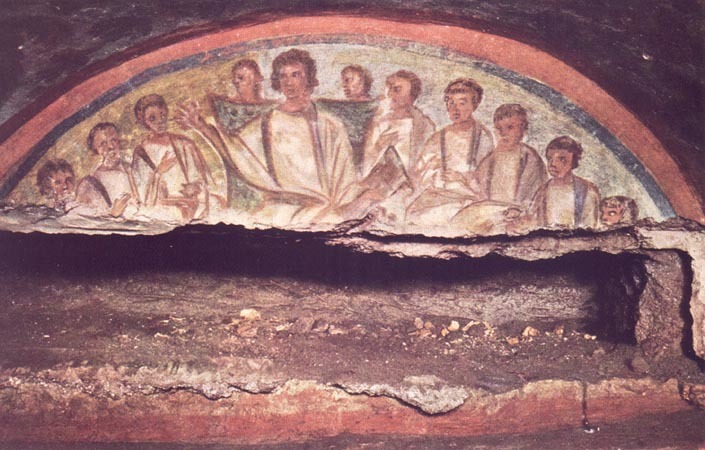Christ Among His Apostles
Item
-
Title
-
Christ Among His Apostles
-
Description
-
Today, little of early Christian art remains. The earliest pieces date back to the second century and many of these pieces were used to decorate the sarcophagi of deceased Christian worshippers. The frescoed painting above, Christ Among His Apostles, is such an image, created in either the late 3rd century or early 4th century, this depiction of Christ with his Apostles decorated the area above a sarcophagi in the Catacomb of Domitilla in Rome. From the picture, the sarcophagi looks to have been removed leaving only the painting remaining.
On first glance, Christ Among His Apostles might seem like a depiction of The Last Supper, however, it is important to note that Christ Among His Apostles was painted well over a millennia before Leonardo da Vinci began work on his famous depiction of the supper. Many works depicting Christ and the Apostles after 1497 reference da Vinci’s work in some way as this painting has stuck with the world as a key Christian painting. However, Christ Among his Apostles has cultural significance because in addition to being one of the earliest Christian paintings, it gives us insight into how Christians viewed Christ and His Apostles before da Vinci’s influence. Similar to the last supper, Christ gains authority in this painting by being placed in the center of the image surrounded by his disciples. He can be seen reading from a scroll in elegant clothing while the disciples intently listen to his oration.
The location of the painting, the Catacomb of Domitilla, is significant because it offers clues to the Christians living in Rome between the second century and the ninth centuries. Before the second century, Christians in Rome were buried among the Pagans on the outskirts of Rome. However by the fourth century the Church had enough land to begin having places of burial for Christians in the city. The Catacombs of Domitilla are an instance of this progress and were started when Flavia Domitilla, a Christian noblewoman who was a granddaughter to a past emperor. She gave land to the Church that would later be used for burial purposes. Christian saints were buried at this site and for seven centuries this Catacomb was a popular Christian burial site reaching seventeen kilometers of underground caves and four complete stories of catacombs. The tombs were lost from public knowledge for centuries until they were rediscovered by Antonio Bosio in 1593.
-
Subject
-
Early Depictions of Christ
-
Creator
-
Flavia Domitilla and the excavators of St. Domitilla
-
Date
-
late 3rd century to 4th century A.D.
-
Format
-
fresco painting

